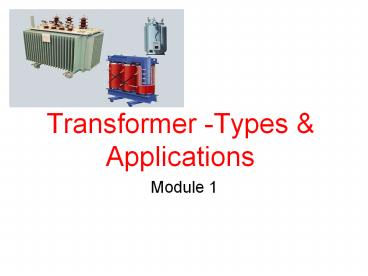Transformer -Types - PowerPoint PPT Presentation
Title: Transformer -Types
1
Transformer -Types Applications
- Module 1
2
What are transformers?
- Transformers are electrical devices used to
convert or "transform" AC voltage from one level
to another. (high to low or low to high) - Input and output are AC
- They do this by the principle of electromagnetic
induction
3
Transformer
4
(No Transcript)
5
Symbol of Transformer
6
Parts of a Transformer
- A transformer consists of 3 basic components
- Primary Coil or Primary Winding It is an
electrical wire wrapped around the core on the
input side - Secondary Coil or Secondary Winding It is an
electrical wire wrapped around the core on the
output side - Core A ferromagnetic material that can conduct
a magnetic field through it. Example Iron
7
Transformer Structure
8
Transformer Operation
- An electrical transformer normally consists of a
ferromagnetic core and two coils called
"windings". - A transformer uses the principle of mutual
inductance to create an AC voltage in the
secondary coil from the alternating electric
current flowing through the primary coil. - The voltage induced in the secondary can be used
to drive a load.
9
What is Mutual Inductance?
- The principle of mutual inductance says that when
two electrical coils are placed near to each
other, AC electrical current flowing in one coil
induces an AC voltage in the other coil. - This is because current in the first coil creates
a magnetic field around the first coil which in
turn induces a voltage in second coil
10
Mutual Inductance
11
- The transformer improves the efficiency of the
transfer of energy from one coil to another by
using a core to concentrate the magnetic field. - The primary coil creates a magnetic field that is
concentrated by the core and induces a voltage in
the secondary coil
12
Transformer Operation
13
Turns Ratio
- The voltage at the secondary coil can be
different from the voltage at the primary. This
happens when the number of turns of the coil in
primary and secondary are not the same - The Turns Ratio (TR) is the ratio of the number
of turns in the primary coil to the number of
turns in the secondary coil
14
(No Transcript)
15
(No Transcript)
16
Formulas
- TR Vp / Vs
- Also TR Np /Ns
- So we can say
- Vp / Vs Np /Ns
- Also Vp/VsIs /Ip
17
Transformer Voltages Currents
18
Problems
- A transformer has a primary voltage of 230v and
turns ratio of 51. Calculate the secondary
voltage - A transformer has 200 turns in the primary, 50
turns in the secondary, and 120 volts applied to
the primary (Vp). What is the voltage across the
secondary (V s)?
19
More Problems.
- There are 400 turns of wire in an iron-core coil.
If this coil is to be used as the primary of a
transformer, how many turns must be wound on the
coil to form the secondary winding of the
transformer to have a secondary voltage of one
volt if the primary voltage is five volts? - A 12 volts transformer has 20 turns in the
primary, 5 turns in the secondary. What is the
voltage across the primary side (VP)?
20
Lab Activity 2
- Complete Pages 19 -22 of Module 1
21
Input Power and Output Power of a Transformer
- Under ideal conditions input power and output
power should be the same. But there is power loss
between the primary and secondary and so
practically they are not exactly equal. - So, Pin Pout Ploss
22
Transformer Efficiency
- The power loss is converted to heat . The heat
produced can be found by calculating the
transformer efficiency.
23
Transformer Types
- Isolation Transformer
- Autotransformer
24
Isolation Transformer
- In isolation transformer, the primary and
secondary are physically isolated (no electrical
connection)
25
Advantages of Isolation Transformer
- Voltage spikes that might occur on the primary
are greatly reduced or eliminated in the
secondary - If the primary is shorted somehow, any load
connected to the secondary is not damaged - Example In TV monitors to protect the picture
tube from voltage spikes in main power lines
26
Autotransformers
- An autotransformer uses only one coil for the
primary and secondary. - It uses taps on the coil to produce the different
ratios and voltages.
27
The Control Transformer
- A control transformer is used to reduce voltage
from the main power line to a lower voltage that
operates a machines electrical control system.
28
The Control Transformer
- The most common type of control transformer has
two primary coils (H1H2 and H3H4) and one
secondary coil (X1X2). Note that the primary
windings are crossed
29
To get 120V at the secondary from 240 V at the
primary using a control transformer
30
It is actually a parallel connection of the
primary coils
31
To get 120V at the secondary from 480 V at the
primary using a control transformer
32
This is actually a series connection of the
primary coils
33
Problem 1
- Connect the primary coils in parallel and
calculate the secondary voltage if the primary
voltage is 48 Volts and the number of turns in
each primary is 50 turns and the secondary has 25
turns.
34
Problem 2
- Connect the primary coils in series and calculate
the secondary voltage if the primary voltage is
48 Volts and the number of turns in each primary
is 50 turns and the secondary has 25 turns.
35
Problem 3Make connections in the transformer
coils to produce a turns ratio of 11. Use both
primary and secondary coils.
36
Problem 4Make connections in the transformer
coils to produce a turns ratio of 21. Use both
primary and secondary coils.
37
Problem 5What is the turns ratio in the circuit?
38
Problem 6What is the turns ratio in this circuit?































